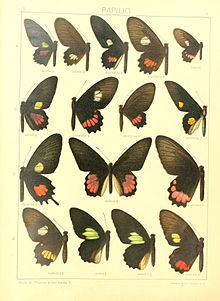Parides klagesi is a species of butterfly in the family Papilionidae. It was thought to be endemic to Venezuela before being discovered in Brazil. A recent, freely available article by Olaf Mielke and Mirna Casagrande (2007) summarizes the known geographical distribution of the species. Because of the prior CITES listing and apparent rarity, this species was placed in the endangered species list for the northern Brazilian state of Pará.
| Parides klagesi | |
|---|---|

| |
| Scientific classification | |
| Domain: | Eukaryota |
| Kingdom: | Animalia |
| Phylum: | Arthropoda |
| Class: | Insecta |
| Order: | Lepidoptera |
| Family: | Papilionidae |
| Genus: | Parides |
| Species: | P. klagesi
|
| Binomial name | |
| Parides klagesi | |
Description
editA peculiar little species in which the hinder angle of the cell on the forewing is quite rounded; neither the forewing nor the hindwing has distinct fringe-spots. Forewing with a white band before the hindmargin; hindwing with a band composed of red spots. Abdomen entirely black, even at the tip.[3] The male, taken only in 1983, is described by Racheli and Pischedda (1987) [4][5] A full description of the female is provided by Rothschild, W. and Jordan, K. (1906)[6] BOA images
-
Novitates Zoologicae 1906 Pl.V
-
Entomological News 1904 Description of Parides klagesi
Habitat
editSeasonal semideciduous monsoon forest. On clay soil.
Status
editA rare and little-known species known only from the semideciduous forests of Imataca and Imeri refugia and, likely the Belem refuge in Brazil (Santo Antônio do Tauá). One female in the British Museum (Nat. Hist.) London, is labeled "Mts. Aureos, Maranham, T. Belt".
Etymology
editNamed for the professional American collector, Samuel M. Klages.
References
edit- ^ Grice, H.; Freitas, A.V.L.; Rosa, A.; Dias, F.M.S.; Mega, N.; Marini-Filho, O.; Mielke, O.; Casagrande, M. (2019). "Parides klagesi". IUCN Red List of Threatened Species. 2019: e.T16243A145166241. doi:10.2305/IUCN.UK.2019-1.RLTS.T16243A145166241.en. Retrieved 16 November 2021.
- ^ Ehrmann, G. A. (1904). "New forms of exotic Papilionidae". Entomological News. 15 (6): 214–215.
- ^ Jordan, K., in Seitz, A. ( 1907) . The Macrolepidoptera of the World. 5: The Macrolepidoptera of the American faunistic region. Papilionidae 1-45 This article incorporates text from this source, which is in the public domain.
- ^ Tommaso Racheli and Marina Pischedda, 1987 The hitherto unknown male of Parides klagesi (Ehrmann, 1904) (Lepidoptera: Papilionidae) Atalanta, (Juli 1987) 18: 113-116, Würzburg, ISSN 0171-0079 [online at Zobodat
- ^ Collins, N. Mark; Morris, Michael G. (1985). "Parides klagesi (Ehrmann, 1904)". Threatened Swallowtail Butterflies of the World: The IUCN Red Data Book. Gland & Cambridge: IUCN. p. 67. ISBN 978-2-88032-603-6 – via Biodiversity Heritage Library.
- ^ Rothschild-Rothschild, Lionel Walter; Jordan, Karl (1906). "A revision of the American Papilios". Novitates Zoologicae. 13 (3): 411–752. doi:10.5962/bhl.part.22801.
External links
edit- Mielke, Olaf H. H.; Casagrande, Mirna M. (2007). "Parides klagesi (Ehrmann) redescoberto no Brasil (Lepidoptera, Papilionidae, Troidini)". Revista Brasileira de Entomologia. 51 (2): 187–189. doi:10.1590/S0085-56262007000200007.
- MNHN de Paris images
